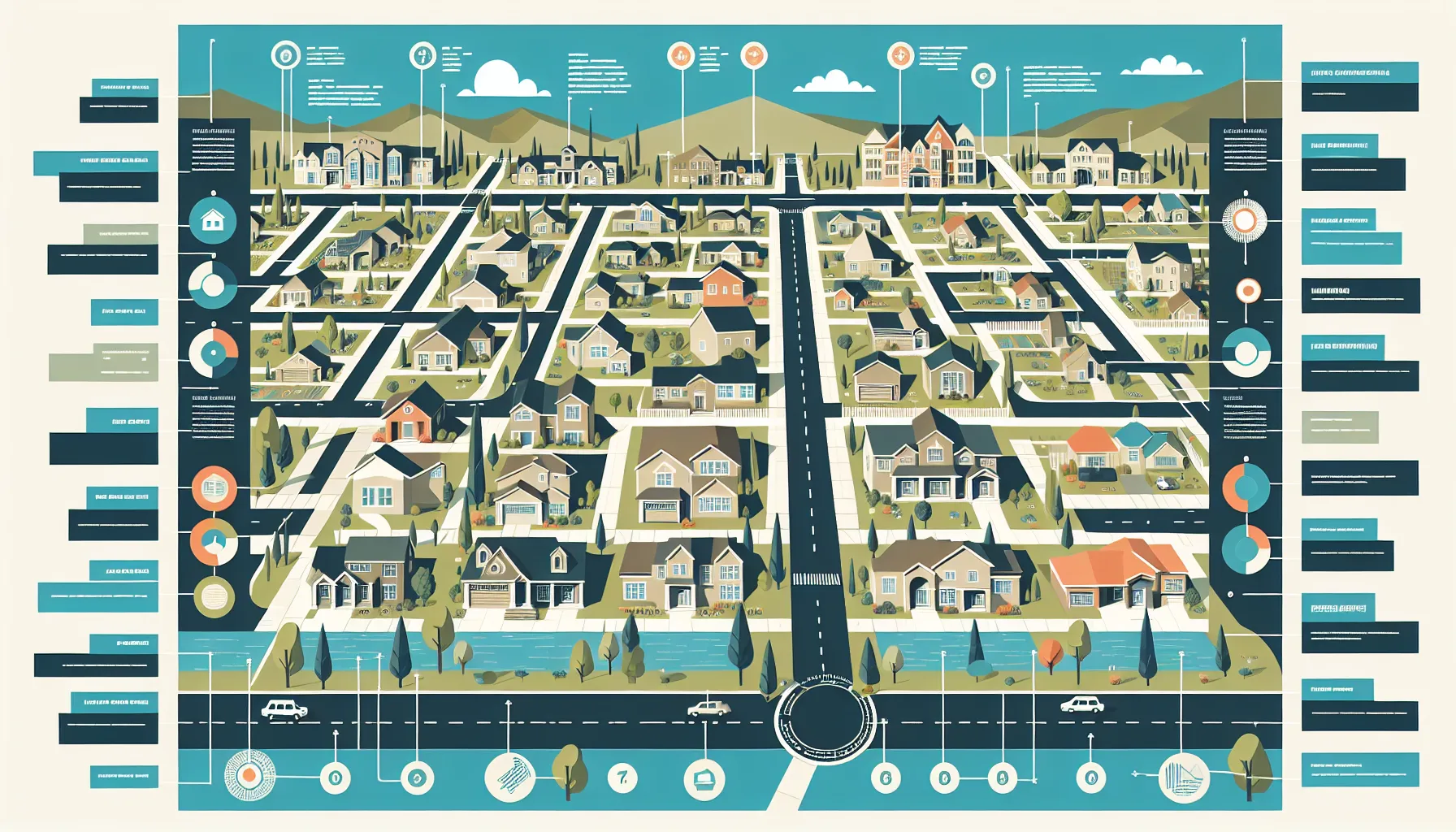Key Takeaways
- Rental market analytics in Danville provide essential data on current rent prices, vacancy rates, and property returns, helping property owners and investors make informed decisions.
- Key metrics to track include vacancy rates (typically 3.5%–5.5%), average rent for three-bedroom homes ($3,200–$4,100/month), rental yield (4%–6%), and management fees (6.5%–8% of rent).
- Local trends such as population growth, shifting demographics, and a strong job market directly impact demand, occupancy rates, and rent pricing in Danville’s rental market.
- Using reliable tools—such as online rental databases and local government sources—ensures access to up-to-date insights for better investment and management strategies.
- Understanding seasonal patterns, expense breakdowns, and neighborhood comparisons empowers property owners to maximize income and reduce vacancy risks.
Understanding rental market analytics in Danville can feel overwhelming, especially with so many numbers and trends to consider. I know how important it is to have clear, reliable insights when you’re deciding where to invest or how to manage your property. With rents, fees, and property values shifting, it’s easy to feel uncertain about your next move.
Have you ever wondered how local pricing, leasing fees, or maintenance costs could impact your rental income? You’re not alone. Many property owners and investors want straightforward data to guide their decisions. Let’s break down the numbers and trends shaping Danville’s rental market so you can feel more confident about your choices.
Understanding Rental Market Analytics in Danville
Rental market analytics in Danville give me precise data about current market rates, occupancy trends, and returns. This information tells me how competitive my property is and helps me make smart choices. What’s most important to you—steady income, long-term value, or ease of management?
I often find property values in Danville fluctuate based on factors like location, property condition, and recent renovation projects. Seeing how other rentals compare in terms of monthly rent, tenant turnover, and maintenance costs guides my strategy. For example, three-bedroom homes near schools typically draw higher rent, while older properties sometimes need extra investment.
Analyzing rental data saves time and reduces stress. Online resources, property inspection results, recent leasing fees, and average management fees combine to create a clear picture. For properties ranging from $10,000 to $30,000 in monthly gross rents, average leasing fees stick to about $199, while monthly management fees range between 7% and 7.5%. Are you curious how these percentages translate into actual results for your own rental?
Examining historical trends in Danville reveals patterns such as increased demand in spring or slight rate drops in late fall. Understanding these cycles puts me in a better position to minimize vacancies. Does your experience match these trends, or have you noticed something different?
Staying aware of property management costs—like maintenance inspections averaging $75 or project oversight at 7.5% of improvement costs—helps me manage my investment efficiently. Local rental analytics simplify decision-making, letting me anticipate changes and prepare effectively. What data would help you feel more confident about your rental decisions?
Key Metrics to Track in Danville’s Rental Market

Tracking a few core metrics in Danville’s rental market helps me see the bigger picture and spot opportunities for better returns. Am I comparing properties or thinking about long-term growth? Focusing on the right data points gives me confidence.
Vacancy Rates
Vacancy rates in Danville show me how quickly properties rent and whether demand aligns with available supply. A lower vacancy rate—often below 5% in stable East Bay communities like Danville, based on regional averages—means homes are occupied more frequently, reducing lost income. Higher rates point to extra competition or overpriced listings.
When I review vacancy data for single-family homes, townhouses, and condos, I consider seasonal changes. Summer often brings increased rentals, so comparing year-over-year numbers matters. Shifts in local employment or new housing developments can cause vacancy swings. Have I checked how my property type compares to the local average?
Average Rental Prices
Tracking average rental prices tells me what tenants currently pay across Danville. Recent surveys in the East Bay area report rents for three-bedroom homes ranging from $3,200 to $4,100 monthly, though exact amounts depend on location, upgrades, and amenities. With these figures, I can price my property competitively and spot above-market rent opportunities.
Rental price trends also reveal whether rates rise, hold steady, or decline. Have I noticed price growth in nearby cities like Brentwood or Pleasanton? This context helps me forecast income and assess if updates or marketing investments might justify higher rents.
Rental Yield and ROI
Rental yield, calculated by dividing annual rental income by property value, tells me how well my investment generates cash flow. In Danville, average rental yields can range from 4% to 6%, similar to nearby East Bay markets, depending on home price and rent levels.
I also look at return on investment (ROI), which factors in expenses such as property management fees, maintenance, leasing costs, and closeout fees. For example, Danville management fees typically run from 6.5% to 8% of monthly rent, with additional leasing and maintenance costs. Comparing net returns across different packages and property types helps me choose where to invest or adjust strategy. How am I calculating my own yields? Am I including all relevant costs in my breakdown?
| Metric | Danville Range | Details & Context |
|---|---|---|
| Vacancy Rate | 3.5% – 5.5% | Lower rates = faster leasing, higher demand |
| Avg. 3-Bedroom Rent | $3,200 – $4,100/month | Based on location, condition, amenities |
| Rental Yield | 4% – 6% | Annual rent ÷ property value, varies by property |
| Management Fees | 6.5% – 8% of rent | Additional fees: setup, leasing, close-out, etc. |
Have I reviewed these metrics for my properties lately, or am I due for a deeper analysis? Keeping these numbers in mind gives me a clearer path in Danville’s rental market and helps inform every decision I make.
Tools and Resources for Rental Market Analysis in Danville

Finding reliable tools for rental market analysis in Danville makes a difference for property owners and investors. I focus on sources that provide up-to-date data and help make sense of local rental trends. Are you curious about how to better interpret the numbers that shape your rental decisions?
Online Platforms and Databases
I use online platforms and rental data aggregators to access current and historical information about Danville properties. These platforms supply vacancy rates, typical rent levels for different home sizes, and neighborhood comparisons. By checking listing sites and rent tracking dashboards, I spot trends in days-on-market or seasonal shifts. Comparing reports across sites gives me a well-rounded perspective. Have you checked how these rent averages align with what tenants are seeking right now?
Local Government Data
Public records from local government sources play a role in my analysis. I look at housing and rental surveys, property tax records, and planning department updates. These data points show changes in permits, development pipeline size, and recent rental unit additions. Reviewing city council meeting notes or published housing reports helps me stay ahead of regulatory shifts and infrastructure updates in Danville. What local data do you find most useful for understanding shifts in your property’s value or rental demand?
Trends Shaping Danville’s Rental Market

Understanding the trends driving Danville’s rental market gives property owners and investors an advantage. Reliable data helps you adapt strategies and get better results. Are you curious about what’s shifting in demand, or how economic shifts may affect returns? Here’s what’s making a difference right now.
Population Growth and Demographics
Population changes directly influence Danville’s rental market. Growing families and professionals moving into town increase rental demand, especially for larger homes and condo units. In 2023, Danville’s population reached nearly 45,000, up 2.3% compared to five years prior. This steady growth boosts occupancy rates and raises rent levels.
Age and household trends matter, too. A larger share of residents are aged 35–54 years, which often correlates with stable incomes and a preference for long-term leases. Households with children tend to seek three or more bedrooms, while young professionals usually look for one- or two-bedroom rentals. Have you noticed more long-term renters in your properties lately? These shifting demographics shape leasing patterns and rental pricing.
Economic Factors and Job Market
Job growth directly impacts rental pricing and occupancy in Danville. High employment rates in the San Ramon Valley, plus proximity to tech and healthcare hubs, keep demand for quality rentals steady. The median household income in Danville stands at approximately $160,000, which supports a higher rent threshold than many neighboring cities.
Low unemployment—averaging 2.7% in recent years—gives more residents the confidence to rent upscale properties. When companies expand or open local offices, new hires often seek rental housing before buying. Economic shifts, such as remote work trends, also change rental needs with some tenants prioritizing home office space. How do these trends align with what you’re seeing in your own rental properties?
Staying informed about population and economic shifts lets you price rentals more competitively and select properties that match current demand. Local data helps you move ahead with better insights every quarter.
How to Use Analytics for Better Investment Decisions

I use analytics to clarify which properties in Danville deliver the most reliable returns. By tracking average rent prices, I identify which neighborhoods and property types attract steady tenants. Have you noticed how some areas in Danville rent faster than others? Those trends aren’t random. Numbers highlight patterns, showing where demand rises or declines during certain seasons.
Analyzing vacancy rates helps me decide when to list or relist a rental. Low vacancy means faster turnovers and less time with properties sitting empty. For each property, I compare rental yields by dividing annual rent earned by the purchase price, then multiplying by 100. This simple calculation reveals which homes generate better cash flow.
I always include all management and maintenance expenses when reviewing returns. For example, monthly management fees in Danville typically range from 6.5% to 8% of rent, plus leasing and marketing charges. Do you ever wonder if management costs are affecting your profits? Tracking these numbers lets me adjust my strategy to protect my bottom line.
Understanding seasonal rental patterns also shapes my decisions. Rent prices often peak during spring and summer, so I plan lease renewals and marketing boosts accordingly. I ask myself—am I timing my decisions to match these natural fluctuations, or am I missing key opportunities?
Comparing my data with regional trends and local government reports helps me stay prepared for changes. For example, when new development brings more families to Danville, demand for larger rentals climbs. By using analytics this way, I spot growth opportunities and avoid costly surprises.
How are you currently using rental data in your investment approach? Sometimes, simply starting with vacancy rate and rent price trends makes all the difference in shaping a stronger, more confident strategy.
Conclusion
Staying on top of Danville’s rental market analytics has given me a real edge when it comes to making smart investment choices. I’ve found that using reliable data sources and tracking key metrics can turn uncertainty into opportunity.
If you want to maximize your returns and reduce stress, it pays to keep a close eye on trends and adjust your strategy as the market shifts. With the right tools and a data-driven mindset, navigating Danville’s rental landscape feels a lot more manageable.
Frequently Asked Questions
What are the most important rental market metrics to track in Danville?
Key metrics include vacancy rates, average rental prices, rental yield, and return on investment (ROI). Tracking these gives insight into demand, property competitiveness, and potential returns.
How do property management and leasing fees affect my rental investment?
Property management and leasing fees typically range from 6.5% to 8% of monthly rent in Danville. These fees impact your total returns, so it’s essential to account for them when calculating your investment profitability.
Where can I find reliable rental market data for Danville?
Reliable sources include online rental platforms, data aggregators, local government housing surveys, and property tax records. These resources offer up-to-date and historical market information to assist your decisions.
What factors influence rental prices in Danville?
Rental prices are influenced by location, property condition, renovations, seasonal demand, and broader economic trends such as job growth and local demographics.
How do I calculate rental yield and ROI for a Danville property?
Rental yield is calculated by dividing annual rental income by the property’s purchase price. ROI considers rental income minus all costs (fees, maintenance, taxes), divided by the total investment, providing a fuller picture of profitability.
Are vacancy rates in Danville currently high or low?
Vacancy rates in Danville are generally low, indicating strong rental demand and faster leasing times, especially for well-maintained properties in desirable neighborhoods.
What typical rent can I expect for a three-bedroom home in Danville?
As of 2023, three-bedroom homes in Danville typically rent between $3,200 and $4,100 per month, depending on factors like location, size, and upgrades.
How can rental analytics help reduce stress for property owners?
Rental analytics provide clear data on pricing, trends, and occupancy, allowing owners to make informed decisions, save time, and avoid uncertainties in managing properties.
Do seasonal trends affect the Danville rental market?
Yes, seasonal demand impacts rental activity and pricing. Understanding these patterns can help property owners time listings for better rental rates and shorter vacancies.
Why is it important to compare personal data with regional trends?
Comparing personal property performance with regional trends helps spot opportunities, adapt strategies, and avoid costly mistakes by staying informed about the broader market context.
